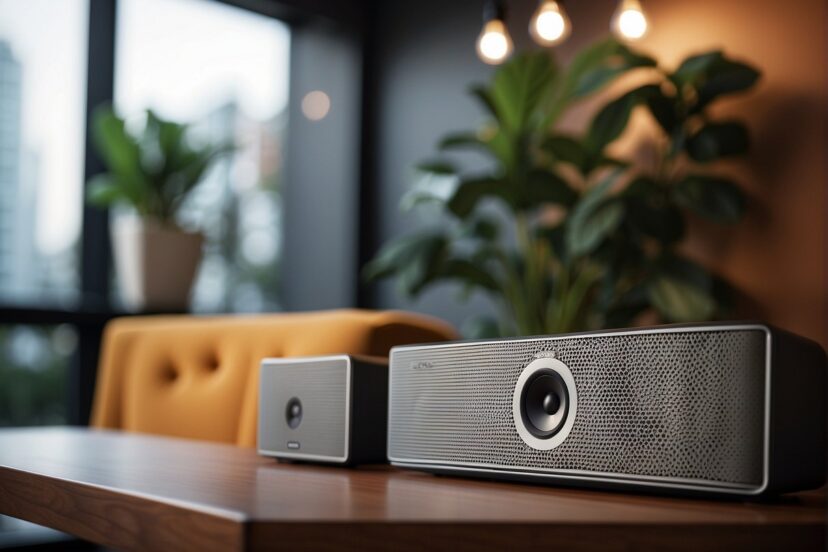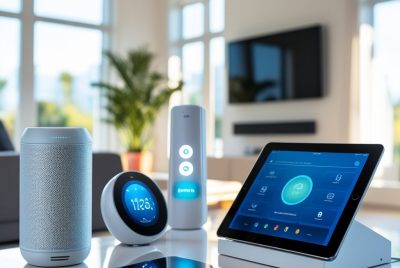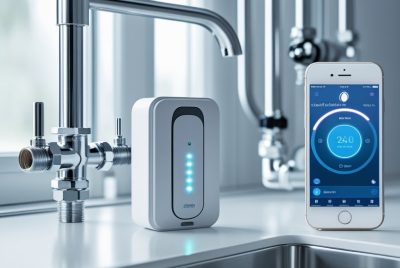Sonos vs Bose: Comparing Sound Quality and Features
*We may earn a commission for purchases made using our links. Please see our disclosure to learn more.
Sonos vs Bose: Comparing Sound Quality and Features
Sonos vs Bose is always the top question I get so let’s jump in! When it comes to premium audio experiences in the home, Sonos and Bose represent two of the leading brands that audiophiles and casual listeners consider. My focus today is on dissecting the nuances between these two giants in the speaker industry. Both companies offer a range of products that promise to deliver superior sound quality, but their approaches to design, features, and overall user experience can be quite distinct.

Sonos has established a reputation for its sleek design and its emphasis on a seamless multi-room audio system. On the other hand, Bose is often lauded for its rich sound quality and has a product line that sometimes proves to be more cost-effective than its competitor’s offerings. These differences can considerably influence a consumer’s decision when selecting a speaker system for their home.
In assessing the most fitting choice between a Sonos or Bose speaker system, it is essential to weigh the comparative audio performance, the aesthetics of the designs, and the range of features each brand brings to the table. Both brands offer smart speakers with voice control capabilities, making them convenient for modern smart homes. My examination will draw on these facets to inform those who are looking to enhance their home audio system with either Sonos or Bose products.
Design and Build Quality

In comparing Sonos and Bose speakers, two definitive aspects stand out: the approach to design and the commitment to build quality. I will closely examine the materials and aesthetics employed by each brand, as well as how their design choices impact durability and the form factor of their products.
Materials and Aesthetics
Sonos:
- Design: Focus on minimalist and modern aesthetics, often with curved edges which contribute to a more sophisticated look.
- Materials: Use of high-quality materials that complement their elegant design ethos.
Bose:
- Design: Offers a variety of designs catering to different tastes, ranging from sleek to more utilitarian looks.
- Materials: Selection includes premium materials, although some users have varied opinions on the consistency of material quality.
Durability and Form Factor
Sonos:
- Durability: Known for robust build quality ensuring their products are durable.
- Form Factor: Products are designed with dimensions that blend into home décor while balancing acoustical performance. Weight is generally considerate of both portability and structural integrity.
Bose:
- Durability: Has a mixed perception when it comes to durability, with some products having a more rugged build than others.
- Form Factor: Provides a broad range inclusive of larger, more substantial Bluetooth speaker options, reflecting a commitment to portability without compromising on sound quality.
Audio Performance

In this section, I will explore the nuances of audio performance between Sonos and Bose systems, focusing on the sound quality and clarity, volume and bass capabilities, and their handling of surround sound and various audio formats.
Sound Quality and Clarity
Sonos: My testing reveals that Sonos systems produce high-end, detailed sound across various ranges. Users typically notice the emphasis on clarity, making Sonos an excellent choice for genres that benefit from nuance.
Bose: In my experience, Bose offers rich sound quality with a focus on warm mids and clear highs. The brand’s audio equipment possesses a signature sound that’s often recognized as full and lifelike, suitable for an array of audio experiences.
Volume and Bass
- Sonos: Known for its balanced audio, Sonos still manages to deliver deep bass, but I’ve found that it excels at maintaining sound quality even at higher volumes, providing a distortion-free listening experience.
- Bose: Bose systems pack powerful volume and are renowned for their deep and immersive bass. My evaluation often points to Bose being the go-to for users seeking robust sound in larger rooms.
Surround Sound and Audio Formats
Surround Sound
- Sonos: With products supporting Dolby Atmos, Sonos provides an enveloping surround sound experience. Although not all models support this, the ones that do, like the Sonos Arc, impress with their spatial audio performance.
- Bose: Most Bose soundbars offer superb surround sound, and with the addition of separate modules, users can enhance the experience. The Bose Soundbar 900, for instance, delivers Dolby Atmos which I find creates a cinematic audio environment.
Audio Formats
- **Sonos aficionados rely on Dolby Digital and Dolby TrueHD support for their high-definition audio needs.
- **Bose fans benefit from similar support and, in some cases, DTS compatibility, which I regard as a plus for versatility and rich audio reproduction in home theaters.
Through my analysis of Sonos vs. Bose in the realm of Audio Performance, I find that both brands excel in their ways, catering to different preferences and uses. Whether you prioritize detailed sound or robust bass will guide your choice between these two industry leaders.
Smart Features and Connectivity
In the competition between Sonos and Bose, their smart features and connectivity options are instrumental elements that define user experience. Both brands offer extensive control and streaming capabilities but differ in specific offerings and integration.
Voice Assistants and Control
Sonos and Bose smart speakers embed voice control through popular assistants like Alexa and Google Assistant. This integration allows me to perform voice commands seamlessly, like playing music or getting daily news updates. Sonos has a slight edge in terms of voice control compatibility, with most of its speakers being equipped with built-in microphones, whereas some Bose speakers require an external device for voice integration.
Wireless and Multi-room Capabilities
When it comes to multi-room audio systems, both Sonos and Bose support Wi-Fi for high-quality streaming and offer the ability to synchronize music playback across different rooms. However, I find Sonos to be particularly robust in this area with its proprietary software allowing for a more straightforward setup of multi-room configurations. Additionally, both Sonos and Bose speakers usually include Bluetooth connectivity, facilitating direct streaming from devices. With the added support of AirPlay 2, Sonos speakers integrate smoothly with Apple devices for multi-room audio.
Software and App Support
Sonos App serves as a central hub for controlling the entire Sonos ecosystem, including streaming services such as Spotify, Apple Music, and more. I’ve noticed the app excels with an intuitive interface that simplifies navigation through different rooms and services. In contrast, Bose uses the Bose Music app to manage connected speakers and soundbars, also supporting various streaming services. Both apps support universal remote capabilities, but Sonos stands out for its broader compatibility and regular updates that enhance the user experience and add new features.
Product Ecosystem and Integration Sonos vs Bose

In the realm of audio equipment, both Sonos and Bose have carved distinctive niches by focusing on the integration of their products into larger ecosystems. I’ll detail how each company’s devices interact with others and the breadth of their ecosystem expansion.
Compatibility with Other Devices
Sonos has pioneered multi-room audio, allowing for a seamless connection between various devices in the Sonos ecosystem. For instance, the Sonos One can be paired with the Playbar for an immersive home cinema experience, offering users the ability to control their entire home audio system from a single app. Sonos supports over 100 streaming services and ensures broad compatibility with third-party smart home platforms.
On the other hand, Bose has built a robust ecosystem around its SoundTouch technology, offering users the ability to integrate multi-room audio into their daily lives. Systems such as the Bose Smart Soundbar 900 and Surround Speakers 700 often feature Bose SimpleSync, which allows for pairing with the Home Speaker 500 for synchronized audio playback.
Ecosystem Expansion
Both Sonos and Bose have emphasized ecosystem expansion, albeit in slightly different ways. Sonos continues to expand its ecosystem by launching new products like the Sonos Beam, offering voice assistance options and ensuring that new speakers are compatible with older ones.
Bose’s approach centers on integrating with other brands and technologies, featuring products like the Bose Smart Soundbar 900, which works with both Google Assistant and Amazon Alexa. These devices also offer HDMI eARC connection capabilities for high-quality audio streaming from televisions and other devices, positioning Bose soundbars as a versatile component in home entertainment setups.
Price Considerations and Value Sonos vs Bose

When examining the pricing and value of Sonos and Bose, I take into consideration both the immediate investment and the long-term value these audio systems can bring to a household or personal setup.
Initial Cost and Investment
- Sonos: Known for high-quality audio products, Sonos tends to come with a higher initial price tag. A typical Sonos One smart speaker can be found at around $219.
- Bose: While also a premium brand, Bose offers products that can be somewhat more affordable. An example is the Bose Home Speaker 300, coming in at prices lower than a comparative Sonos setup.
Long-Term Value
- Sonos: Sonos speakers are designed for a multi-speaker setup, intended to be part of an ecosystem that can be expanded over time. My evaluation finds that investing in Sonos could mean a higher long-term value if multi-room audio is a priority for the user.
- Bose: On the other hand, investing in Bose could be beneficial for users looking for standalone products with rich sound quality. For instance, the Bose Home Speaker 500 is highly praised for its sound quality and could be an excellent solo investment for a main living space.
Frequently Asked Questions for Sonos vs Bose
When comparing Sonos and Bose, many consumers have questions about sound quality, features, performance, user experiences, smart home integration, and multi-room audio setups. I’ll address these common inquiries in detail to help clarify distinctions between the two brands.
1. Which brand offers better sound quality, Sonos or Bose?
In terms of sound quality, both Sonos and Bose have established a reputation for high-quality audio. Sonos often emphasizes a rich, full sound with their products like the Sonos Arc, sporting 11 custom drivers. Bose, on the other hand, uses proprietary technology like PhaseGuide to deliver a broad soundstage, as seen in the Bose Soundbar 900.
2. How do the Sonos and Bose soundbars compare in terms of features and performance?
Comparing soundbars from both brands reveals that Sonos bars typically include more drivers; the Sonos Arc has 11 amplified speakers for a more immersive experience. Features like Dolby Atmos are common in both, yet Bose opts for fewer amplification channels and does not include side-firing drivers like the Sonos Arc does.
3. What are the main differences between Sonos and Bose home theater systems?
For home theater systems, the main differences lie in their setup and audio distribution methodologies. Sonos systems are known for their straightforward wireless connectivity and ability to create a cohesive system with their speakers. Bose systems also offer high-quality audio with unique technologies aimed at aligning sound to the environment for optimal performance.
4. Can Sonos speakers integrate better with smart home systems compared to Bose?
Sonos speakers generally have robust integration capabilities with smart home systems, supporting features like voice control extensively. They are compatible with multiple home assistants and can be integrated into various smart home ecosystems more flexibly than some Bose products.
5. What are the advantages and disadvantages of choosing Sonos over Bose for a multi-room audio setup?
Choosing Sonos for a multi-room audio setup often means easier integration and synchronization across rooms thanks to their SonosNet technology. However, a potential disadvantage could be the cost at entry, as Sonos speakers may be more expensive. Bose provides high-quality alternatives but may not offer the same level of seamless multi-room connectivity as Sonos.




